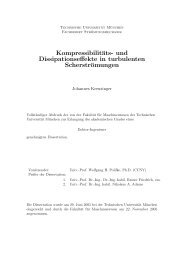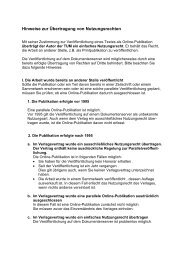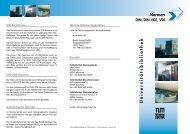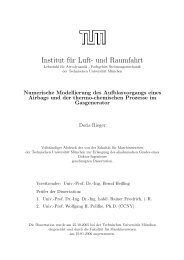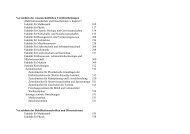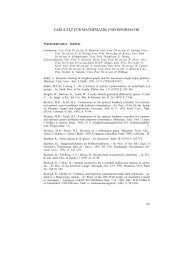LES of shock wave / turbulent boundary layer interaction
LES of shock wave / turbulent boundary layer interaction
LES of shock wave / turbulent boundary layer interaction
Create successful ePaper yourself
Turn your PDF publications into a flip-book with our unique Google optimized e-Paper software.
29<br />
directions are 45.8 and 17.7. Here the friction velocity u τ = √ τ w /ρ w<br />
and the kinematic viscosity at the wall ν w = µ w /ρ w are based on mean<br />
flow quantities. The <strong>boundary</strong> <strong>layer</strong> is resolved by 58 gridpoints in wallnormal<br />
direction, and by 2 points in the viscous sub<strong>layer</strong>. Such a resolution<br />
is found to be sufficient for the considered flow parameters (Stolz<br />
& Adams, 2003).<br />
As initial data an instantaneous solution was taken from the previous<br />
flat plate simulations <strong>of</strong> Stolz & Adams (2003) and rescaled to match the<br />
required Mach number and domain size. Since in the previous simulation<br />
the domain width was only one third <strong>of</strong> the current, the initial field was<br />
composed by repeating this field three times in spanwise direction. The<br />
simulation was run long enough, so that a statistically stationary state<br />
was reached. Sequentially it was continued for 55.7δ 0 /U ∞ characteristic<br />
time-scales. Of all conservative variables (density, momentum and<br />
total energy) 400 samples were taken at evenly spaced consecutive time<br />
increments roughly spaced by 0.14δ 0 /U ∞ at the downstream position<br />
x r = 11.15. for the estimation <strong>of</strong> mean and statistical quantities and for<br />
inflow preparation. In the following we distinguish between Favre, i.e.<br />
density-weighted statistical averages and Reynolds averages. The former<br />
is indicated by a double prime f ′′ = f − 〈ρf〉 / 〈ρ〉 = f − {f}, the latter<br />
by a single prime f ′ = f − 〈f〉.<br />
3.1 Instantaneous structures<br />
The instantaneous flow field can be visualized in terms <strong>of</strong> the density<br />
field. Figure 3.1 reveals the existence <strong>of</strong> organized motions in the outer<br />
<strong>layer</strong>, which is characterized by the occurrence <strong>of</strong> large-scale intermittently<br />
appearing structures. These structures are separated from the<br />
surrounding essentially irrotational fluid by sharp interfaces having a<br />
three-dimensional character. Unlike the DNS, the <strong>LES</strong> resolution is not<br />
sufficient to show them clearly. The angle <strong>of</strong> the structures agrees with<br />
the values 45 − 60 ◦ reported by Spina et al. (1994). They move downstream<br />
at approximately 90% <strong>of</strong> the freestream velocity. The average<br />
spanwise extent <strong>of</strong> the largest eddies is approximately 1/2δ in the outer<br />
<strong>layer</strong>, and decreases towards the wall.<br />
The near-wall resolution is sufficient to capture fine structures. The<br />
existence <strong>of</strong> elongated streaky structures <strong>of</strong> alternating high and low<br />
speed near the wall is illustrated in figure 3.2 by the wall-normal component<br />
<strong>of</strong> vorticity ω z . The wall-parallel plane is located at x + 3 = 8.5.



